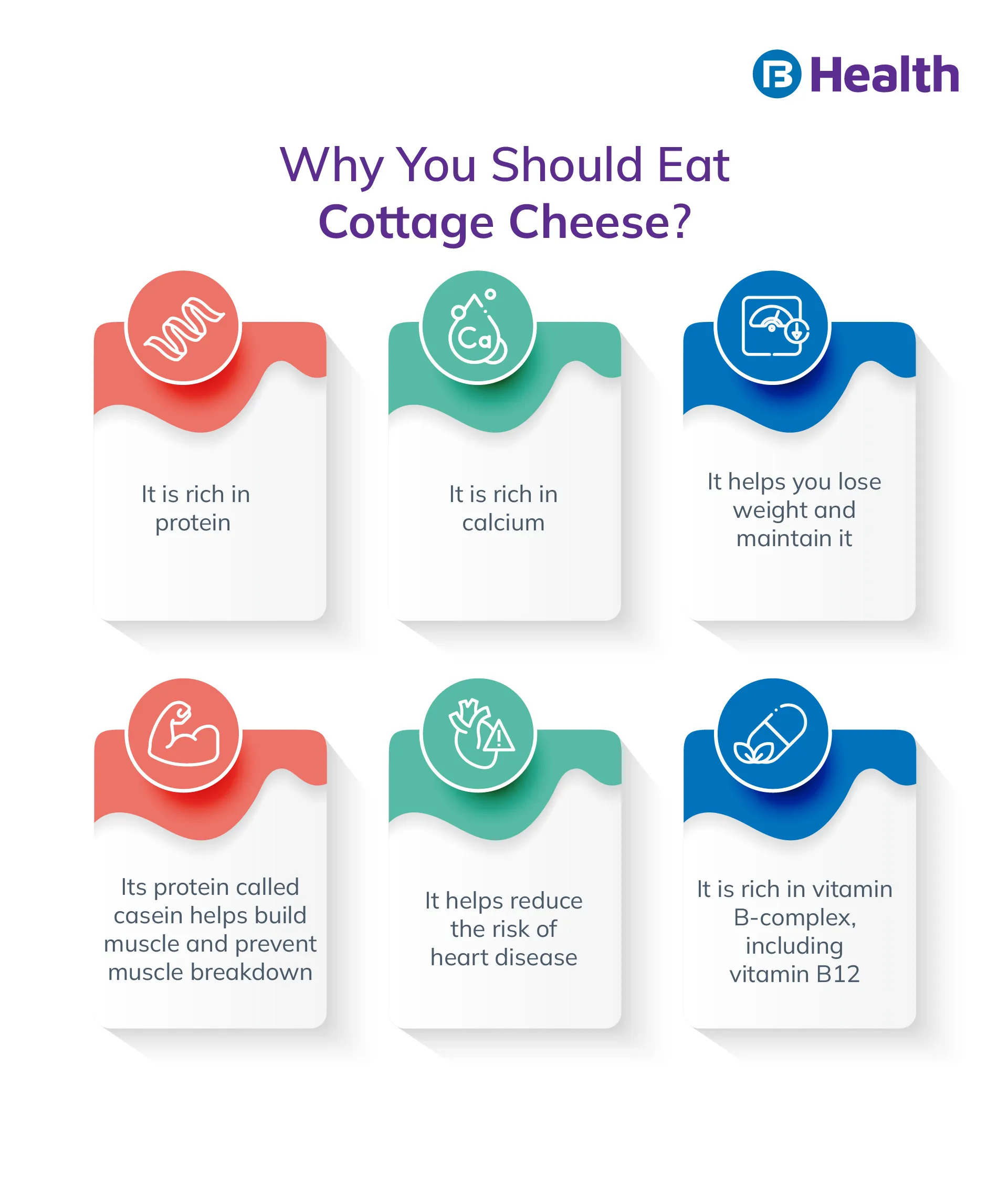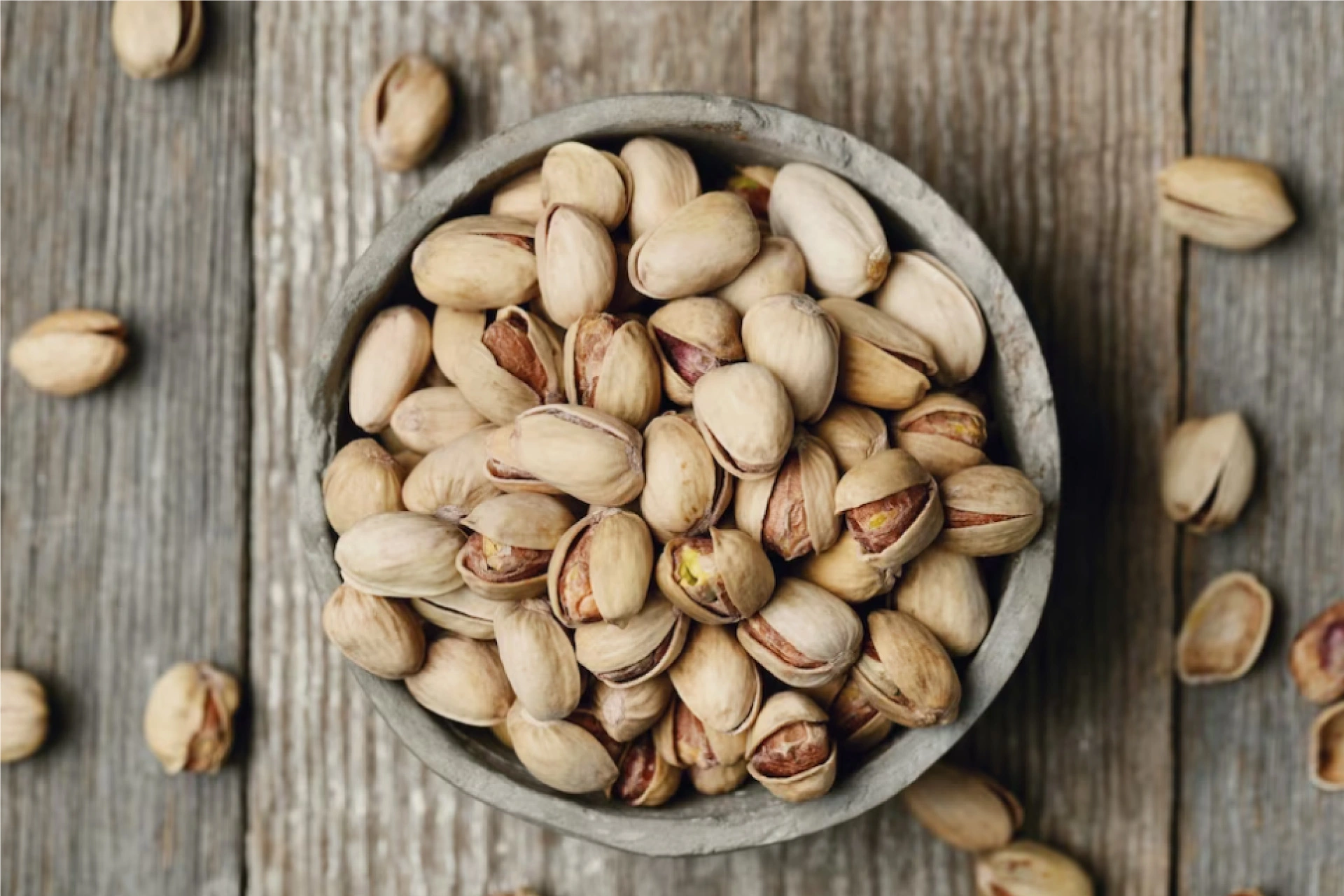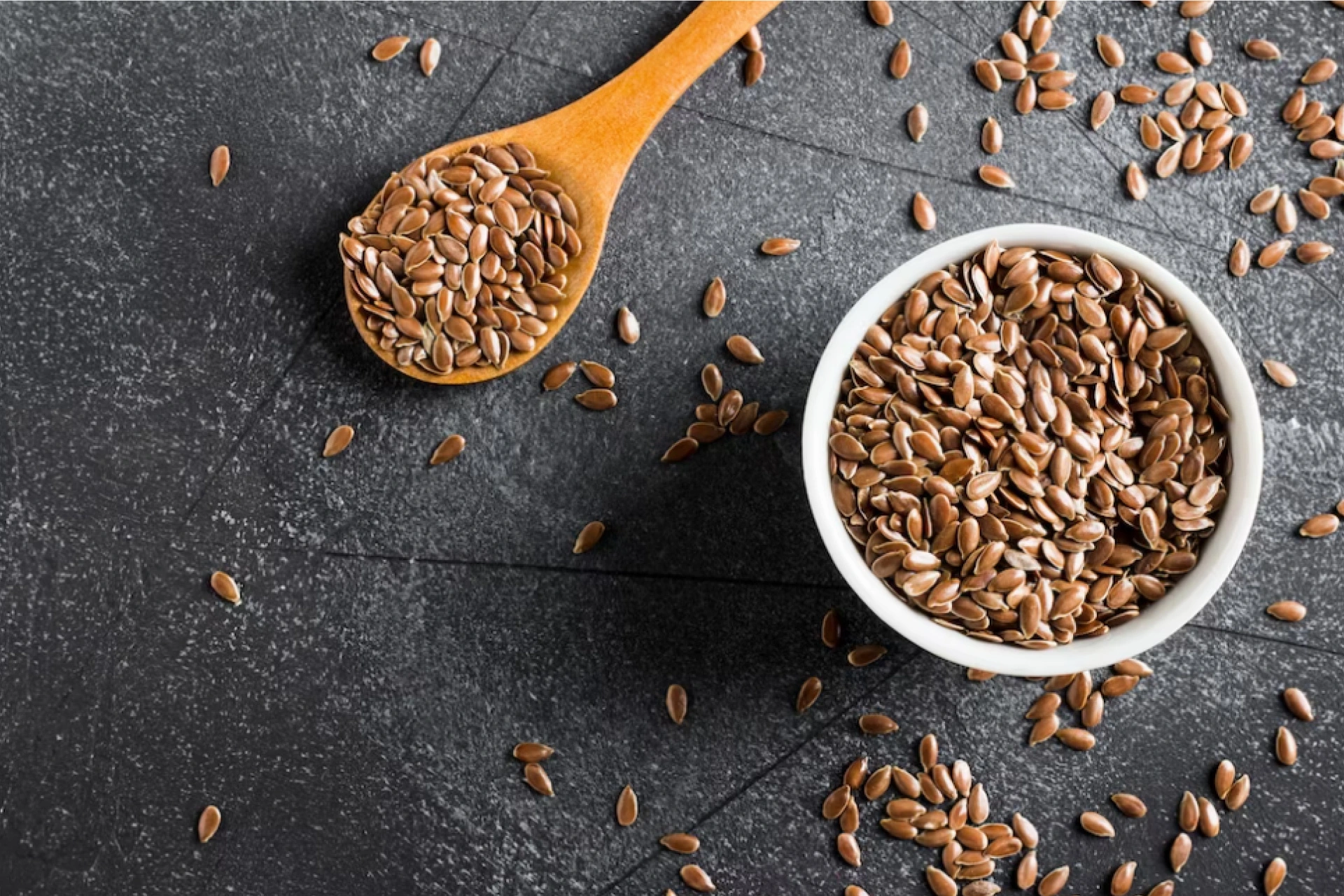Nutrition | 8 min read
Cottage Cheese: Benefits, Recipe and Risk Factor
Medically reviewed by
Table of Content
Synopsis
Cottage cheese is made from milk and is rich in nutrients. It has many benefits but also has some risks in having it, especially in excess. You can make it easily at home with a few simple steps.
Key Takeaways
- Cottage cheese is rich in nutrition, especially protein and calcium
- It has many benefits but some risks too. It is not suitable for lactose intolerant people
- It is easy to make at home with a few basic ingredients
Cottage cheese is made from milk by adding an acidic element to it. This separates the curds and whey. Whey is the thin liquid left after the curds (the solid part) are removed. [1] Cottage cheese is soft, tastes sour, and is served fresh. While there are many kinds of cheese that are aged, like cheddar and parmesan, this one is not.
It can be eaten as it is with some seasoning, as a snack, or as an addition to a dish. A healthy vegetarian diet usually includes this cheese. It isn’t just a tasty food item. The various cottage cheese benefits make it a good addition to the diet. It does, however, have some risks associated with it.
Let’s take a look at the benefits and risks of cottage cheese.
Cottage Cheese Benefits
Cottage cheese has many nutrients that make it a healthy choice. Because this cheese is made from milk, it will not be beneficial for people who are lactose intolerant and can cause them digestive problems. For those who can digest lactose, it can be a part of a healthy diet plan that covers all food groups. Here are some benefits of this cheese:
Rich in Protein
This cheese is rich in protein. 100 gm of cottage cheese made from milk with 2% milk fat contains 11 gm of protein. [2] It is an easy source of protein, especially for those who only eat vegetarian food. This is a good option if you are looking for protein-rich foods to include in your diet.
Helpful in losing weight
Cottage cheese is low in calories and rich in protein. Specifically, it is rich in casein protein. This protein is absorbed by the body slowly, leading to slower metabolization. As a result, eating this cheese will make you feel full for a longer time compared to other foods. You will get the necessary protein with fewer calories. Also, you will not get a hunger pang and can avoid unhealthy eating habits. These effects can help you lose weight. With cottage cheese weight loss is a benefit and it also helps maintain it.
Additional Read: Weight Loss Smoothies
Helps build muscle
The casein protein in this cheese helps build muscle and prevent muscle breakdown. The low-fat cottage cheese releases amino acids in the muscles and blood, which decreases the risk of muscle breakdown.
Healthy for your bones
Cottage cheese is rich in calcium. 100 gm of this cheese made from milk with 2% milk fat has 103 mg of calcium. [3] A healthy calcium intake helps make the bones healthy. You can avoid any bone-related ailments like osteoporosis if you maintain healthy bones.
Good source of vitamin B-complex
This cheese consists of vitamin B elements essential to the body. It has vitamin B12 required for healthy brain function and to absorb iron. It has pantothenic acid that helps in making fats, proteins, carbohydrates, and amino acids. Riboflavin aids the conversion of carbohydrates into energy. Thiamin helps convert sugar into energy. Niacin is vital in digestion, reduction of cholesterol, and energy production. Folate helps produce red blood cells. With all these, this cheese is a healthy food choice.
Helpful in reducing the risk of heart diseases
The vitamin B12 present in cottage cheese can lower the body’s homocysteine levels. Homocysteine is a type of amino acid, abnormal levels of which indicate a greater risk of cardiovascular diseases. Including it in your diet can help you to have a heart healthy .
More suitable than other types of cheese for diabetics
This cheese is low in carbohydrates and natural sugars but high in protein. Proteins stabilize blood sugar levels to some extent. Together with low sugar content, this makes it suitable for diabetics, especially compared to other kinds of cheese.

Cottage Cheese Risks
Cottage cheese has many benefits. However, it also has some risks because of its nutritional composition. Here are the risks associated with it:
May cause kidney issues
This cheese is high in protein. If you have other protein-rich foods in your diet already, this is going to increase your protein intake considerably. A healthy intake of protein is necessary for a balanced diet. However, this may lead to an excess intake that can put pressure on the kidneys to digest the protein. If this goes unchecked for a long time, it can lead to kidney problems.
Lactose intolerant people can get gastrointestinal problems
Cottage cheese is a dairy product. Lactose is a milk sugar present in dairy products and requires the enzyme lactase to break it down into simple sugars. [4] Those who don’t have this enzyme or have an insufficient amount in their system can’t absorb lactose and are lactose intolerant. When lactose isn’t absorbed, it can cause intestinal distress and gas. Therefore, this cheese is not suitable for lactose intolerant people. However, there are cases where a general physician will prescribe medicines that bring lactase into the system to help digest dairy products.
Can raise blood pressure
Cottage cheese has a high amount of sodium. Eating it regularly in considerable quantities can lead to high blood pressure. If someone already suffers from high blood pressure, it can make it worse.
Additional Read: High Blood Pressure Symptoms in WomenPossibility of an allergy
It is possible that someone may be allergic to dairy. Being allergic to the milk protein casein can trigger a reaction to any dairy product, including cottage cheese. The reaction may show itself as itching, hives, facial swelling, trouble breathing, or anaphylaxis.
Damage from excess calcium
Much like protein, calcium is necessary for a healthy body. But cottage cheese is rich in calcium, and if you add it to an already calcium-rich diet, it may lead to excess calcium consumption. This can lead to harm instead of benefit. Excess calcium in the blood, called hypercalcemia, can weaken the bones, lead to constipation, and pressure the kidneys to work harder, causing frequent urination and abnormal levels of thirst. It can also cause pain in the bones and muscle weakness, fatigue, frequent headaches, lethargy, and confusion.
Cottage Cheese Recipe
Cottage cheese is easy to make at home. With so many benefits, given that you are not lactose intolerant, making this at home can add more nutrition to your diet.
The recipe is simple and only requires a few ingredients that are easily available at home. Here is the recipe for cottage cheese:
Ingredients required:
- 1 liter full cream milk (whole milk)
- 2 tablespoon vinegar or lemon juice
- Salt (optional)
Steps
- Pour the milk in a pot and heat it slowly at medium heat. Do not use high heat as this can burn the milk at the bottom of the pan. Stir it from time to time.
- Decrease the heat and add 2 tbsp vinegar or lemon juice to the milk.
- Stir the milk and continue till it begins to curdle.
- Stir lightly till the curds form completely.
- You will have whey (runny liquid remaining once the curds have separated) and curds separated. A way to know if the curds have completely formed is to check the whey. It should be a clear liquid and not milky anymore. These curds are the cottage cheese we are making here.
- Turn off the heat and let this cool.
- Take a colander and a large bowl.
- Place the colander over the bowl.
- Put a cheesecloth or a tea towel on the colander.
- Now pour the cooled curd and whey into the colander to strain the curds. The whey will be collected in the bowl below, and you will have the curds in the colander. The whey is nutritious, so you don’t have to throw it away. You can use it in sauces, gravies, etc., later.
- Take the cheesecloth from its edges to form a ball of curd inside it.
- Squeeze it lightly till no more whey is left.
- Run cold water over the cheesecloth with the curds inside it. This is to rinse the vinegar or lemon that would otherwise leave a sour flavor. Squeeze it again gently to remove the excess water.
- Transfer these curds to another bowl.
- Add salt for taste (optional). You can add other seasonings also if you want, depending on how you want to use the cheese.
- Mix it through, and the cottage cheese is ready!
Store the cheese in an airtight container. You can have it with toast, add it to a salad, or use it as an ingredient for other recipes. The options are limitless! Now you can make this healthy cheese at home without much hassle.
Cottage cheese is a simple food item that is packed with nutrition. You can incorporate it into your diet through savory or sweet dishes. Adding it to your diet will give you the necessary calcium, protein, and much more.
As good as it is to add cottage cheese to your meals, you should be careful not to have it in excess. You should first assess your diet. If it is already rich in nutrients, calcium, vitamin B12, etc., adjust the other parts of your diet when you add this cheese to your regular diet. The idea is to have a balanced diet while utilizing cottage cheese at a healthy level. In case you have any deficiencies or any ailments, you can get doctor consultation from Bajaj Finserv Health easily.
References
- https://www.oxfordlearnersdictionaries.com/definition/english/whey?q=whey
- https://fdc.nal.usda.gov/fdc-app.html#/food-details/328841/nutrients
- https://fdc.nal.usda.gov/fdc-app.html#/food-details/328841/nutrients
- https://www.britannica.com/science/lactase
Disclaimer
Please note that this article is solely meant for informational purposes and Bajaj Finserv Health Limited (“BFHL”) does not shoulder any responsibility of the views/advice/information expressed/given by the writer/reviewer/originator. This article should not be considered as a substitute for any medical advice, diagnosis or treatment. Always consult with your trusted physician/qualified healthcare professional to evaluate your medical condition. The above article has been reviewed by a qualified doctor and BFHL is not responsible for any damages for any information or services provided by any third party.





